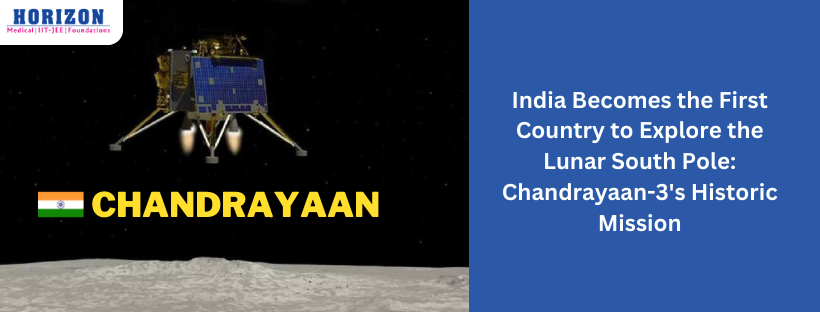India Becomes the First Country to Explore the Lunar South Pole: Chandrayaan-3’s Historic Mission
Chandrayaan-3’s Historic Mission: The Moon has always had a unique attraction in the vastness of space. With every new mission to the lunar surface, humanity takes small but important steps towards uncovering the mysteries hidden within its craters and plains. Now, the Indian Space Research Organisation (ISRO) is gearing up for another historic mission with Chandrayaan-3, the third installment in India’s journey to the Moon. In this blog, Horizon Institute in Yamuna Vihar will delve into the importance of Chandrayaan-3, its thrilling goals, and the crucial role played by the lunar south pole in our exploration efforts.
The Importance of Chandrayaan-3
Chandrayaan-3 marks an epochal moment in India’s space endeavors. Notably, this mission aims to achieve a soft landing on the elusive lunar south pole, a feat no spacecraft has achieved before. The mission follows in the footsteps of Chandrayaan-1 and Chandrayaan-2, each stepping stones towards a comprehensive understanding of the Moon.
Unveiling the Lunar South Pole
Why the south pole, you wonder? Well, the Moon’s south pole is like a treasure chest full of secrets. Scientists believe it has ice, which is super important for exploring the Moon. Ice can be used for drinking water, but it’s even more exciting because it can be turned into fuel for rockets. That could make it much easier to go on long missions in space. So, this hidden stash of resources has made the Moon’s south pole a really big deal for scientists.
Fascinating Tidbits
Chandrayaan-3 isn’t just any space mission. It’s a clear sign of India’s strong dedication to exploring space. The lander, Vikram, and the rover, Pragyan, are named after important people in India’s space journey: Vikram Sarabhai and Pragyan Chandrashekhar. This connection to history makes the mission even more important.
The spacecraft is packed with state-of-the-art scientific tools. From a camera to map the Moon’s surface to a device that can figure out what minerals are on the Moon and another that can study its environment, Chandrayaan-3 is all set to look at the Moon like never before. Its job? To uncover the Moon’s past, how it has changed over time, and what valuable stuff it might have.
A Glimpse into the Future
As we prepare for Chandrayaan-3’s launch, there’s a buzz of excitement. ISRO, India’s space agency, aims to use this mission to discover more about the Moon’s history, how it transformed over billions of years, and the thrilling chance of finding water ice. This knowledge isn’t just for the books; it will shape how we explore the Moon in the coming years.
Chandrayaan-1 and Chandrayaan-2: A Brief Recap
Before Chandrayaan-3, there were Chandrayaan-1 and Chandrayaan-2. Chandrayaan-1, which took off in 2008, was a big surprise. It showed us that there’s water ice in the Moon’s polar areas, changing what we knew about what the Moon is made of. Chandrayaan-2, launched in 2019, did something amazing too. It put a lander and rover on the Moon, even though the lander Vikram had a tough landing. These missions set the stage for what Chandrayaan-3 is trying to do with its ambitious goals.
Anticipation Builds
With the launch of Chandrayaan-3 slated for 2023 and its landing projected for 2024, the anticipation is palpable. India’s quest to soft-land on the lunar south pole is not only a scientific endeavor but also a testament to the nation’s technological prowess.
Unlocking Lunar Mysteries
The mission has several goals, but one of the most important is to find water ice. If Chandrayaan-3 confirms that it’s there, it could change how we explore the Moon. It might allow us to do long missions and even set up bases there. The Moon, which we used to think was empty, could become a crucial place for exploring space further.
India’s Place in Space
India’s role in space exploration is becoming increasingly important. With Chandrayaan-3, the country is set to make significant progress in lunar research, possibly positioning itself as a leader in exploring the Moon. As ISRO prepares for this groundbreaking mission, it highlights India’s growing abilities and determination to expand the frontiers of human knowledge.
Conclusion
Chandrayaan-3’s Historic Mission: In the grand tapestry of cosmic exploration, Chandrayaan-3 is a chapter brimming with promise. As the mission embarks on its journey, it carries with it the hopes and aspirations of a nation and humanity at large. With each pixel of lunar soil analyzed, we draw closer to understanding our celestial neighbor and unlocking the mysteries it guards. Chandrayaan-3 isn’t just a spacecraft; it’s a testament to human curiosity, perseverance, and the unending quest for knowledge.
We should be proud of our country and ISRO, who make this remarkable goal true,
Horizon academy will try to influence more and more students and make them interested in space, so that India will get more and more brilliant scientists like we have in ISRO.
If you are looking for a reputed institute in yamuna vihar for your NEET preparation , then you can join horizon academy. This institute in yamuna vihar is the best institute in yamuna vihar for NEET and JEE.
Trust Horizon academy because;
“We Create Miracles”










